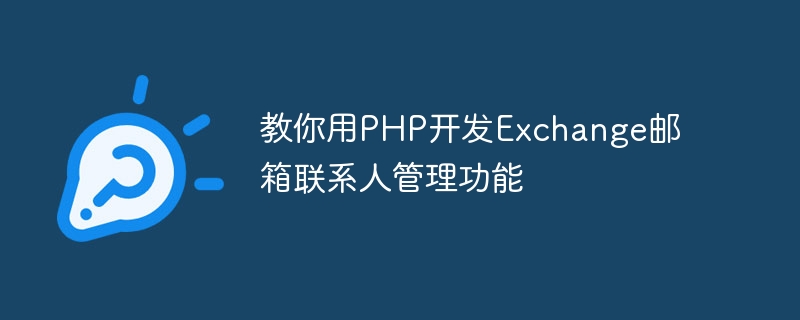

We often use Exchange mailbox to manage our emails and contacts. In many cases, we may need to develop some custom functionality to meet our specific needs. This article will introduce how to use PHP to develop Exchange mailbox contact management functions.
Exchange is a commonly used mail server that uses Microsoft's Microsoft Exchange Server software to provide email and contact management services. Exchange Server uses an API called Exchange Web Services (EWS) to provide developers with access to mail and contacts.
First, we need to make sure PHP is installed on our server. Then, we need to install PHP's EWS library, which provides functionality to access the Exchange server. You can find this library on GitHub and follow the instructions to install it.
After installing the library, we can start writing code. First, we need to introduce the library file:
require_once 'ews/ExchangeWebServices.php'; require_once 'ews/EWSType.php';
Next, we need to create an object to connect to the Exchange server:
$ews = new ExchangeWebServices($hostname, $username, $password);
Among them, $hostname is the address of the Exchange server, $username is the login The username of the email, $password is the password. Please replace these values as appropriate.
Now, we can start using the functions provided by the EWS library to perform various operations. Here are a few examples:
$request = new EWSType_FindItemType(); $request->ItemShape = new EWSType_ItemResponseShapeType(); $request->ItemShape->BaseShape = EWSType_DefaultShapeNamesType::ALL_PROPERTIES; $request->Traversal = EWSType_ItemQueryTraversalType::SHALLOW; $request->ParentFolderIds = new EWSType_NonEmptyArrayOfBaseFolderIdsType(); $request->ParentFolderIds->DistinguishedFolderId = new EWSType_DistinguishedFolderIdType(); $request->ParentFolderIds->DistinguishedFolderId->Id = EWSType_DistinguishedFolderIdNameType::CONTACTS; $response = $ews->FindItem($request); $contacts = $response->ResponseMessages->FindItemResponseMessage->RootFolder->Items->Contact;
The above code will return a contact array containing the details of all contacts.
$request = new EWSType_CreateItemType(); $request->Items = new EWSType_NonEmptyArrayOfAllItemsType(); $request->Items->Contact = new EWSType_ContactItemType(); $request->Items->Contact->GivenName = 'John'; $request->Items->Contact->Surname = 'Doe'; $response = $ews->CreateItem($request);
The above code will create a contact named John Doe.
$request = new EWSType_UpdateItemType(); $request->ItemChanges = new EWSType_NonEmptyArrayOfItemChangesType(); $request->ItemChanges->ItemChange = new EWSType_ItemChangeType(); $request->ItemChanges->ItemChange->ItemId = new EWSType_ItemIdType(); $request->ItemChanges->ItemChange->ItemId->Id = "AAMkADZjNzU3M2E0LTJjZDctNDIxZC1hNTljLTVmZWI0Mjgz"; $request->ItemChanges->ItemChange->Updates = new EWSType_NonEmptyArrayOfItemChangeDescriptionsType(); $request->ItemChanges->ItemChange->Updates->SetItemField = array(); $request->ItemChanges->ItemChange->Updates->SetItemField[] = new EWSType_SetItemFieldType(); $request->ItemChanges->ItemChange->Updates->SetItemField[0]->FieldURI = new EWSType_PathToUnindexedFieldType(); $request->ItemChanges->ItemChange->Updates->SetItemField[0]->FieldURI->FieldURI = "contacts:CompanyName"; $request->ItemChanges->ItemChange->Updates->SetItemField[0]->Contact = new EWSType_ContactItemType(); $request->ItemChanges->ItemChange->Updates->SetItemField[0]->Contact->CompanyName = "ABC Company"; $response = $ews->UpdateItem($request);
The above code will update the company name of a contact to ABC Company.
Through the above three examples, we can see that it is very simple to use the EWS library to manage Exchange mailbox contacts. We can implement various functions through some simple function calls, such as getting the contact list, creating contacts, updating contacts, etc.
Of course, in actual development, we may also need to handle some abnormal situations, such as server connection failure, insufficient permissions, etc. However, the code for these exception handling is relatively simple and will not be detailed in this article.
To sum up, it is not complicated to use PHP to develop Exchange mailbox contact management functions. By using EWS library, we can easily implement various functions. I hope this article can help you better use PHP to manage Exchange mailbox contacts.
The above is the detailed content of Teach you to use PHP to develop Exchange mailbox contact management functions. For more information, please follow other related articles on the PHP Chinese website!